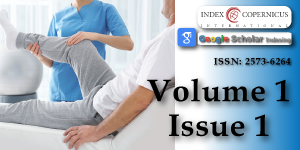Effects of Fast-Walking on Muscle Activation in Young Adults and Elderly Persons
Main Article Content
Abstract
Coactivation of agonist and antagonist muscles participates in the regulation of joint stiffness and postural instability. Alterations on muscle activity have been revealed as an important falling risk factor. It is unclear the effects, and age-related differences, of a prolonged demanding task on the muscular coactivation levels. We compared muscle activation amplitude and coactivation of the vastus medialis, biceps femoris, tibialis anterior, and gastrocnemius medialis from surface EMG in 16 young adults (age 21-33) and 8 elderly adults (age 66-72) while fast-walking at 70% of their maximum heart rate. Overall, the elderly demonstrated higher coactivation indexes than the young individuals. Ankle coactivation decreased in the first half of the swing phase, while coactivation at the knee increased in the latter half of the swing phase in our elders. Alterations of muscle activation and coactivation on the knee and ankle were more prominent close to landing and in the swing phase. Our results suggest that these alterations may suggest potential concerns with respect to the risk of falls.
Article Details
Copyright (c) 2017 de Oliveira, et al.

This work is licensed under a Creative Commons Attribution 4.0 International License.
Eurostat (2015) People in the EU - who are we and how do we live?
Tinetti ME, Speechley M. Prevention of falls among the elderly. N Engl J Med. 1989; 320: 1055-1059. Ref.: https://goo.gl/bT5qfS
Gandevia SC. Neural control in human muscle fatigue: Changes in muscle afferents, moto neurones and moto cortical drive. Acta Physiol Scand. 1998;162: 275-283. Ref.: https://goo.gl/7vBovO
Lee LW, Kerrigan DC. Identification of Kinetic Differences Between Fallers and Nonfallers in the Elderly1. Am J Phys Med Rehabil. 1999; 78: 242-246. Ref.: https://goo.gl/251ra3
Hortobagyi T, DeVita P. Muscle pre- and coactivity during downward stepping are associated with leg stiffness in aging. J Electromyogr Kinesiol. 2000; 10: 117-126. Ref.: https://goo.gl/c6gx10
Peterson DS, Martin PE. Effects of age and walking speed on coactivation and cost of walking in healthy adults. Gait Posture. 2010; 31: 355-359. Ref.: https://goo.gl/b4TYlP
Pereira M, Gonçalves M. Effects of fatigue induced by prolonged gait when walking on the elderly. Human Movement. 2011; 12: 242-247. Ref.: https://goo.gl/ZZiJwC
Fan Y, Li Z, Han S, Lv C, Zhang B. The influence of gait speed on the stability of walking among the elderly. Gait Posture. 2016; 47: 31-36. Ref.: https://goo.gl/lkmB42
Nagano H, James L, Sparrow WA, Begg RK. Effects of walking-induced fatigue on gait function and tripping risks in older adults. J Neuroeng Rehabil. 2014; 11, 155. Ref.: https://goo.gl/kOw0vX
Schmitz A, Silder A, Heiderscheit B, Mahoney J, Thelen DG. Differences in lower-extremity muscular activation during walking between healthy older and young adults. J Electromyogr Kinesiol. 2009; 19: 1085-1091. Ref.: https://goo.gl/oonhiz
Borg GA. Psychophysical bases of perceived exertion. Med Sci Sports Exerc. 1982; 14: 377-381. Ref.: https://goo.gl/ySQrIz
Zeni JA Jr, Richards JG, Higginson JS. Two simple methods for determining gait events during treadmill and overground walking using kinematic data. Gait Posture. 2008; 27: 710-714. Ref.: https://goo.gl/vHmpdq
Kellis E, Arabatzi F, Papadopoulos C. Muscle co-activation around the knee in drop jumping using the co-contraction index. J Electromyogr Kinesiol. 2003; 13: 229-238. Ref.: https://goo.gl/BmDBvg
Hortobágyi T, Solnik S, Gruber A, Rider P, Steinweg K, et al. Interaction between age and gait velocity in the amplitude and timing of antagonist muscle coactivation. Gait Posture. 2009; 29: 558-564. Ref.: https://goo.gl/A7IE5b
Mian OS, Thom JM, Ardigo LP, Narici MV, Minetti AE. Metabolic cost, mechanical work, and efficiency during walking in young and older men. Acta Physiol (Oxf). 2006; 186: 127-139. Ref.: https://goo.gl/MpOk2h
Obata H, Kawashima N, Akai M, Nakazawa K, Ohtsuki T. Age-related changes of the stretch reflex excitability in human ankle muscles. J Electromyogr Kinesiol. 2010; 20: 55-60. Ref.: https://goo.gl/XWN8s0
Longpré HS, Potvin JR, Maly MR. Biomechanical changes at the knee after lower limb fatigue in healthy young women. Clin Biomech (Bristol, Avon). 2013; 28: 441-447. Ref.: https://goo.gl/OwOp46
Granacher U, Gruber M, Forderer D, Strass D, Gollhofer A. Effects of ankle fatigue on functional reflex activity during gait perturbations in young and elderly men. Gait Posture, 2010; 32: 107-112. Ref.: https://goo.gl/nRBvXS
Hautier CA, Arsac LM, Deghdegh K, Souquet J, Belli A, et al. Influence of fatigue on EMG/force ratio and cocontraction in cycling. Med Sci Sports Exerc. 2000; 32: 839-843. Ref.: https://goo.gl/v6rQJt
Pereira MP, Gonçalves M. Muscular coactivation (CA) around the knee reduces power production in elderly women. Arch Gerontol Geriatr. 2011; 52: 317-321. Ref.: https://goo.gl/ooGwxU
Parijat P, Lockhart TE. Effects of quadriceps fatigue on the biomechanics of gait and slip propensity. Gait Posture. 2008; 28: 568-573. Ref.: https://goo.gl/f0Zyz5
Hortobágyi T, Mizelle C, Beam S, DeVita P. Old Adults Perform Activities of Daily Living Near Their Maximal Capabilities. J Gerontol A Biol Sci Med Sci. 2003; 58: M453-M460. Ref.: https://goo.gl/Lm6owH
Winter DA. Foot trajectory in human gait: a precise and multifactorial motor control task. Phys Ther. 1992; 72: 45-53; discussion 54-46. Ref.: https://goo.gl/8mXUr7





